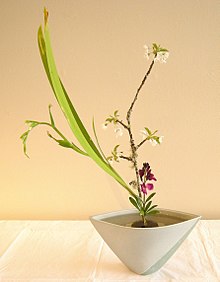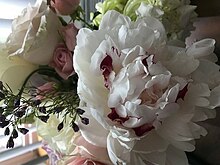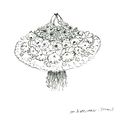Flower bouquet
A flower bouquet is a collection of
History



The arrangement of flowers for home or building decor has a long history worldwide. The oldest evidence of formal arranging of bouquets in vases comes from
In some cultures, ancient practises still survive today; for example, in ikebana, the art of flower-arranging arranging comes from Japan. The oldest known book on flower arranging is Japanese and dates from 1445. Simplicity and linear form are core features of ikebana, which has had a significant influence on Western flower arranging since the late 19th century[1]
Flower arranging as an art form was brought to Japan by Buddhist monks who learned it while in China. In ancient China, flower arranging developed into a highly refined art form based on the principle that life is sacred, including the life of plants. Therefore, cut flowers were used sparingly in carefully planned arrangements. Flowers were a traditional ritual offering among Buddhists, however, and remain so.[1]
In Europe, flower arranging as a formal art was first documented among the Dutch, who "in particular, painted wonderful informal arrangements of flowers. In the 18th century, arrangements were used to decorate the houses of the wealthy families and the aristocracy."[2]
Flower symbolism is common in many cultures and can be complex. In China, certain flowers symbolize seasons: white plum blossoms represent winter, peach and cherry blossoms represent spring, lotus represent summer, and chrysanthemums the fall.[1]
Nosegay
The term "tussie-mussie" is sometimes used interchangeably with nosegay. A nosegay was also known as a "talking bouquet" or "flower poesy" during the Victorian era when they became a popular gift.[3] Traditionally, brides will also carry a small nosegay. Tussie mussies were introduced to England in the early 18th century and were a fashionable accessory for young women by the early 19th century.[4] A tussie mussie is a small circular bouquet like a nosegay but carries symbolic meaning based upon the language of flowers, where particular flowers represent specific sentiments. They were commonly exchanged by lovers, who sent messages to one another based on the flowers used in the bouquet. Traditionally, tussie mussies are arranged in a cone- or cornucopia-shaped container made of tin or silver, with a chain attached for carrying the bouquet.[5]
Language of Flowers
Flower symbolism originated in Asia and the Middle East, where certain flowers, such as the
Wedding Bouquets
Traditionally, the
Wedding Bouquet Shapes
There are many different bridal bouquet styles from which to select. Brides typically choose the shape of their bouquets according to popular trends at the time of their wedding; however, some choose bouquets which evoke another period. While the language of flowers can contribute to a message about the couple, the shapes are a personal preference.
The Posy bouquet is typically round and is thought of as modern due to the small size and relative simplicity of the arrangement. It is also popular for the ease of carrying and passing off during the ceremony. It can be composed of an expensive flower, such as a rose, or a sampling of country flowers.
The Cascading bouquet is usually a large arrangement which tapers near the bottom. It was popularized as the arrangement of choice for the 1980s at the wedding of Lady Diana Spencer and the Prince of Wales at Westminster Abbey. It can, and is often, made up of many kind of flowers and is enhanced with Baby's Breath and different types of greenery, such as ivy. This bouquet became less popular as bridal trends shifted towards simplicity; however, it has found a resurgence in recent years.
The Presentation bouquet grew in popularity at the turn of the twentieth century. It is most frequently composed of a long-stemmed bud, such as the Calla Lily, and is cradled in the bride's arms rather than carried by the stems.
There is a new trend of Ramo Buchon for bridal bouquets. Ramo Buchon is a rose bouquet that is dome-shaped, tightly packed, decorated, and wrapped in fancy paper. This bouquet is the perfect blend of style and substance.[8]
The following gallery shows popular bride's bouquet shapes, including cascading, hand-tied, nosegay, pomander, flower spray and Biedermeier.[9]
-
A modern arrangement.
-
A cascading bouquet shape, with long-stemmed flowers trailing down from the main bouquet.
-
A pomander bouquet, shaped completely round and worn by a ribbon on the wrist.
-
A nosegay bouquet, a round shape and roughly a foot in diameter.
-
A bride holding a hand-tied bouquet, consisting of long-stemmed flowers.
-
A "flower spray" bouquet attached as decor to a pillar.
-
A sketch of a Biedermeier-style bouquet, with concentric rings of flower types and colours.
-
White tulips
See also

References
- ^ ISBN 978-0-88192-247-9.
- ISBN 9780895773579.
- ISBN 978-0-7611-2066-7.
- ^ Laufer et al. p 44
- ^ Laufer et al. p 48
- ^ Early American Society (1990). Early American life, Volume 21. Madison: University of Wisconsin. p. 209.
- ^ Pearce, Cindi. "Garter and bouquet tossing as tradition". Catalogs.com. Retrieved 29 June 2012.
- ^ Ali, Dr. Zoha. "Inspiring Ramo Buchon Ideas for Every Occasion to Impress Your Loved Ones". hortifloral.com.
- ISBN 978-1-55870-560-9.








